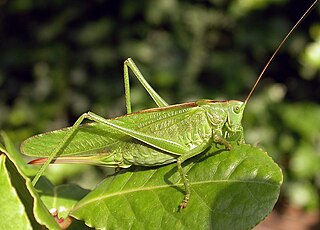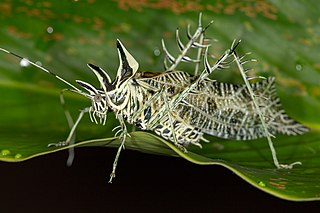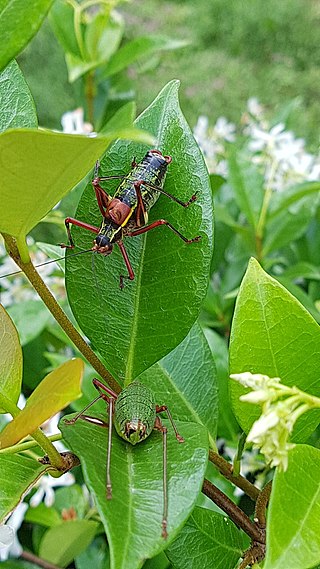
Insects in the family Tettigoniidae are commonly called katydids, or bush crickets. They have previously been known as "long-horned grasshoppers". More than 8,000 species are known. Part of the suborder Ensifera, the Tettigoniidae are the only extant (living) family in the superfamily Tettigonioidea.
The Nihoa conehead katydid is a species of katydid which is endemic to the Hawaiian island of Nihoa. It is one of the ten species in the genus Banza, all of them native to Hawaii, although it is the sister species to the remaining nine, and may belong in a separate genus. It gets its food mostly from plant leaves, but because of the low population, it does not do significant damage. Unlike Main Islands' species, whose males leap on the females before mating, the Nihoa variants sing to them. It is listed as a vulnerable species on the IUCN Red List, and as a "species of concern" under the Endangered Species Act.

The Tettigoniinae are a subfamily of bush crickets or katydids, which contains hundreds of species in about twelve tribes.

Aglaothorax is a genus of ovate shieldbacks in the family Tettigoniidae. There are about six described species in Aglaothorax.
Neduba extincta, the Antioch Dunes shieldback katydid, is an extinct species of katydid that was endemic to California, United States. It was not discovered until after its extinction.

Saga pedo is a species of wingless bush cricket from the southern half of Europe and western and central Asia. This brown or green bush cricket typically has a total length, from the head to the tip of the ovipositor, of up to 10.5 cm (4.1 in), but exceptionally it may reach 12 cm (4.7 in), which makes it one of the largest European insects and one of the world's largest Orthoptera. The head-and-body alone typically is 5–7 cm (2.0–2.8 in) long in adults, but may reach up to 7.8 cm (3.1 in).

Acanthoplus discoidalis is a species in the Hetrodinae, a subfamily of the katydid family (Tettigoniidae). Like its closest relatives, Acanthoplus discoidalis variously bears common names such as armoured katydid, armoured ground cricket, armoured bush cricket, corn cricket, setotojane and koringkriek. The species is native to parts of Angola, Namibia, Botswana, Zimbabwe and South Africa.
Panoploscelis is a genus of very large insects belonging to the true katydid tribe Eucocconotini, which is a subfamily of the Tettigoniidae. Like the other members of the suborder Ensifera, Panoploscelis are part of the insect order Orthoptera, which also contains crickets, grasshoppers and locusts. Members of this genus are among the largest katydids of the Neotropics.
Transkeidectes multidentis, the Transkei shieldback, is a species of katydid in the family Tettigoniidae. It is the only species in the genus Transkeidectes. The species is endemic to Port St. Johns in South Africa.
Thoracistus peringueyi, the Peringuey's seedpod shieldback, is a species of katydid in the family Tettigoniidae. The species is endemic to South Africa, and is listed as critically endangered. It is only known from a male and female specimen that were collected prior to 1879 from a location in Lydenburg district.
Thoracistus arboreus, the arboreal seedpod shieldback, is a species of katydid in the family Tettigoniidae. The species is endemic to Clarens, South Africa.

Eupholidoptera megastyla, the Greek marbled bush-cricket, is a species of 'katydids crickets' belonging to the family Tettigoniidae subfamily Tettigoniinae.

Pterophylla camellifolia, the common true katydid, is a common North American insect in the family Tettigoniidae (katydids). Within the Tettigoniidae, it belongs to the subfamily Pseudophyllinae. Other common names include northern true katydid and rough-winged katydid.

Amblycorypha is a North American genus of round-headed katydids in the family Tettigoniidae. There are about 14 described species in Amblycorypha.
Aglaothorax diminutiva, the diminutive shieldback, is a species of shield-backed katydid in the family Tettigoniidae. It is found in North America.
Aglaothorax gurneyi, commonly known as Gurney's shieldback, is a species of shield-backed katydid in the family Tettigoniidae. It is found in North America.

Aglaothorax morsei, commonly known as Morse's shieldback, is a species of shield-backed katydid in the family Tettigoniidae. It is found in North America.

Markia is a genus in the family Tettigoniidae, sometimes called lichen katydids, which are found in Mexico, Central America and South America, often in highlands; however, the term "lichen katydids" is also used for other genera in the tribe Dysoniini. As suggested by the name, the spiny Markia katydids live and feed on Usnea lichen, and their shape and color pattern provides them with an excellent camouflage in this habitat. They are quite large, with adults typically 4.5–6.5 cm (1.8–2.6 in) long.

Caedicia simplex is a species of bush cricket, native to New Zealand and Australia. Its common name is the common garden katydid.

Barbitistes vicetinus, the Vicentine saw-tailed bush-cricket, is a species of katydids crickets in family Phaneropteridae endemic to Italy. The species was originally described by Antonio Galvagni and Paolo Fontana. It is found in vineyards and woody vegetation in the regions of Veneto and Trentino, in particular in the province of Vicenza. In 2016, it was listed as a Near Threatened species by the IUCN due to its restricted geographic range and extreme fluctuations in its population: its current extent of occurrence (EOO) is about 580 km2 (220 sq mi), and its area of occupancy (AOO) is between 50–100 km2 (19–39 sq mi). Formally described as a new species only in 1993, unexpected population outbreaks have severely impacted forests and crops in northern Italy in recent years.











